
Sangita Mehta, ET Bureau | 25 Dec, 2013, 06.47AM IST
MUMBAI: Soon, you can keep your banker on his toes. Banks will be graded - good, bad or ugly -- and it will all depend on how the teller, the wealth manager or may be the call centre lady hard-selling a credit card behaves with you.
The grades will be given by a new organisation that will behave like a quasi-regulator. Banks, which often mask information that customers want to know, don't really have a choice in the matter. They are willy-nilly agreeing to make the rating public. It can be as big a change for the regulator, which spends most of its time trying to prevent banks from collapsing rather than fostering a service culture that can be dramatically different from bank to bank, and even from branch to branch of the same bank.
Banking Code and Standard Board of India(or, BCSBI), an arm of Reserve Bank of India( RBI), will issue grades like 'high', 'above average', and 'average to poor'. It could force banks to behave better and prompt annoyed customers unhappy with their bank to migrate to another shop. Also, banks that drag their feet to process applications or ask silly questions for opening accounts could lose customers.
"The grading will tell the level of bank's compliance with the code prescribed by BCSBI and this indirectly will reflect on the bank's customer service," said AC Mahajan, a former banker and now the chairman of BCSBI told ET.
The board has already interviewed with 6,000 customers across 3,034 branches over the past few months. What they said would go into finalising the grades which would be put up on the board's website by March or April. BCSBI, which was set up to protect customers' entitlements and rights, will cover 46 banks - state-owned, private as well as a few large foreign banks.
But make no mistake. At times grades could also be deceptive. A poor grade in no reflects that a bank is on its last leg and needs a government lifeline. It's entirely possible that a bank with a comfortable capital cushion that can take on financial storms may end up with a 'poor' grade; and vice-versa. Thus, a poor service rating should not be the only thing that customers should consider while parking a chunk of her life savings; neither should a low grade frighten depositors into withdrawing money. Indeed, the board plans to tell banks that grades -- which could change if service quality drops -- should not be used to market their schemes and attract customers. The move would make India the only country where a quasi-regulator would grade banks on their customer service standards. "Developed countries have legal systems in place to protect consumers.. For instance, America has a Fair Debt Collection Practice for recovery of loan and Truth in Lending Act, under which lenders have to disclose upfront the price -- a combination of fees and interest rate on loans. In the absence of such a legal framework in India, grading of banks service by a recognised institution will go a long way in improving customer services," said M R Umarji, chief legal adviser to banks' lobby Indian Banks' Association.
The grades will be given by a new organisation that will behave like a quasi-regulator. Banks, which often mask information that customers want to know, don't really have a choice in the matter. They are willy-nilly agreeing to make the rating public. It can be as big a change for the regulator, which spends most of its time trying to prevent banks from collapsing rather than fostering a service culture that can be dramatically different from bank to bank, and even from branch to branch of the same bank.
Banking Code and Standard Board of India(or, BCSBI), an arm of Reserve Bank of India( RBI), will issue grades like 'high', 'above average', and 'average to poor'. It could force banks to behave better and prompt annoyed customers unhappy with their bank to migrate to another shop. Also, banks that drag their feet to process applications or ask silly questions for opening accounts could lose customers.
"The grading will tell the level of bank's compliance with the code prescribed by BCSBI and this indirectly will reflect on the bank's customer service," said AC Mahajan, a former banker and now the chairman of BCSBI told ET.
The board has already interviewed with 6,000 customers across 3,034 branches over the past few months. What they said would go into finalising the grades which would be put up on the board's website by March or April. BCSBI, which was set up to protect customers' entitlements and rights, will cover 46 banks - state-owned, private as well as a few large foreign banks.
But make no mistake. At times grades could also be deceptive. A poor grade in no reflects that a bank is on its last leg and needs a government lifeline. It's entirely possible that a bank with a comfortable capital cushion that can take on financial storms may end up with a 'poor' grade; and vice-versa. Thus, a poor service rating should not be the only thing that customers should consider while parking a chunk of her life savings; neither should a low grade frighten depositors into withdrawing money. Indeed, the board plans to tell banks that grades -- which could change if service quality drops -- should not be used to market their schemes and attract customers. The move would make India the only country where a quasi-regulator would grade banks on their customer service standards. "Developed countries have legal systems in place to protect consumers.. For instance, America has a Fair Debt Collection Practice for recovery of loan and Truth in Lending Act, under which lenders have to disclose upfront the price -- a combination of fees and interest rate on loans. In the absence of such a legal framework in India, grading of banks service by a recognised institution will go a long way in improving customer services," said M R Umarji, chief legal adviser to banks' lobby Indian Banks' Association.
The grading idea owes its origin to theDamodaran Committee report released two years ago. "It is difficult for a common man to identify the best service provider and avail the banking services from it. There is no such ready indicator presently available enabling the customer to choose the best possible option available," said the report while recommending that BCSBI should rank banks for services that banks provide.
The rating will be arrived after taking into account several factors such as how compliant the bank is adhering to the banking code prescribed by the BCSBI, interviews and surveys conducted by board's officials, as well as their interactions with RBIand ombudsmen. The board will also give a bank management to give its side of the story before making a grade public.
The rating will be arrived after taking into account several factors such as how compliant the bank is adhering to the banking code prescribed by the BCSBI, interviews and surveys conducted by board's officials, as well as their interactions with RBIand ombudsmen. The board will also give a bank management to give its side of the story before making a grade public.
